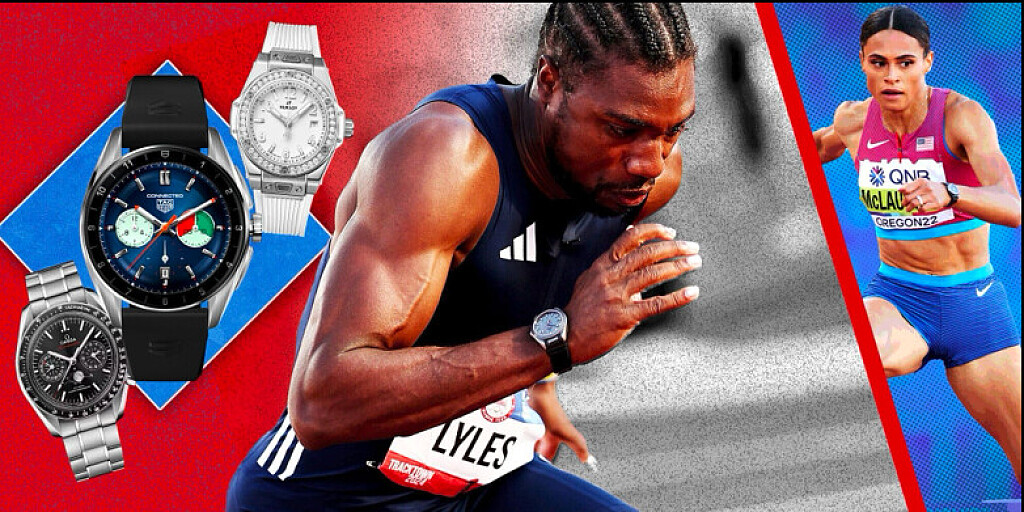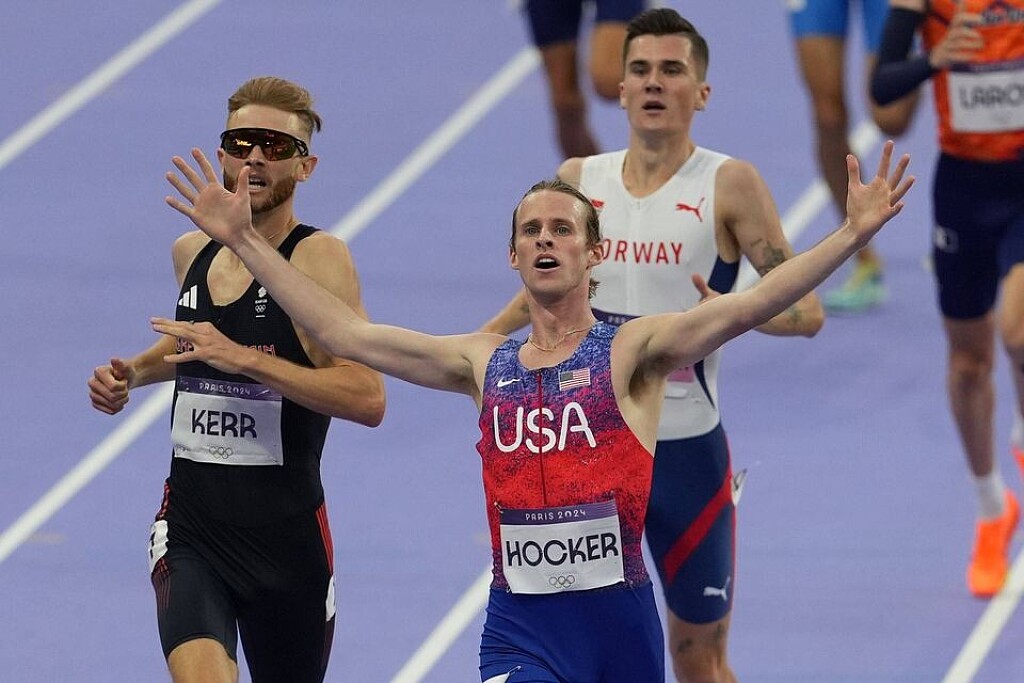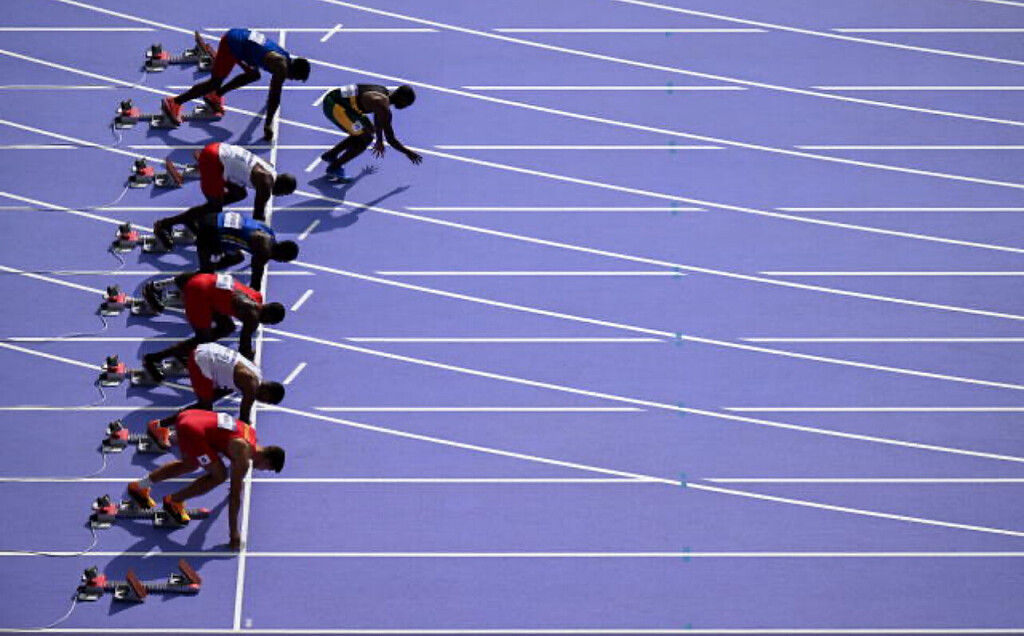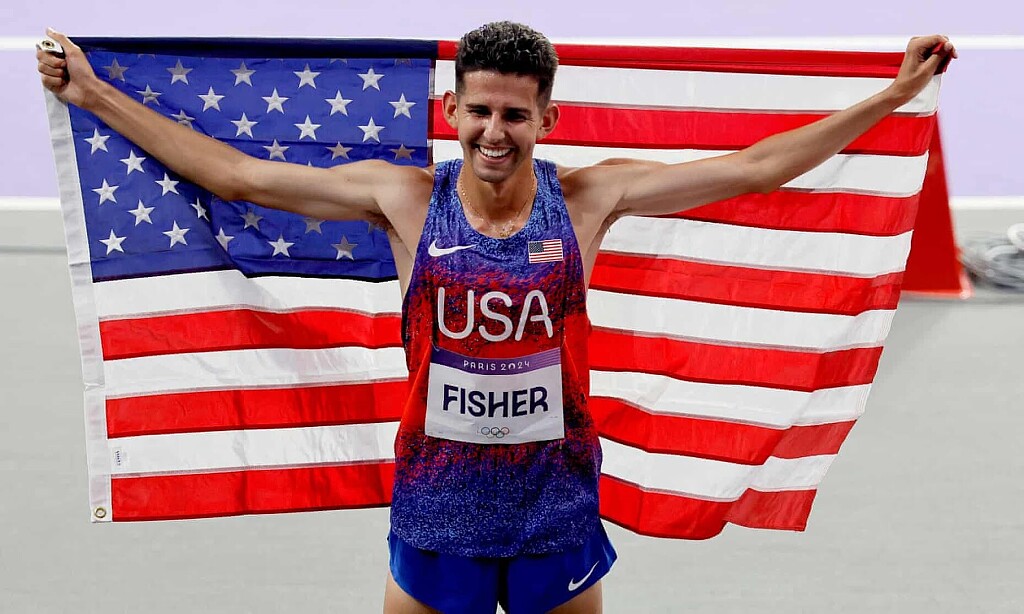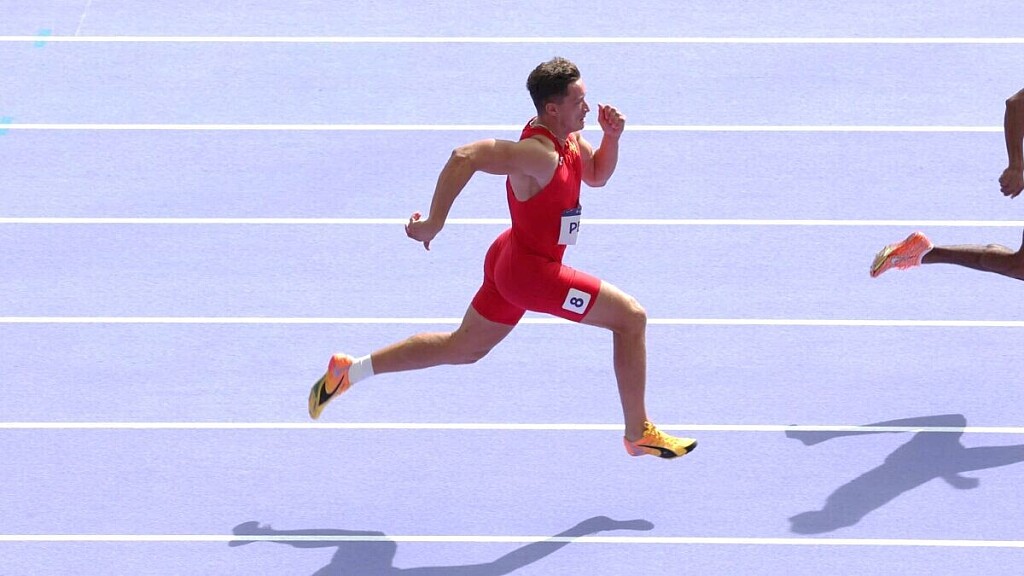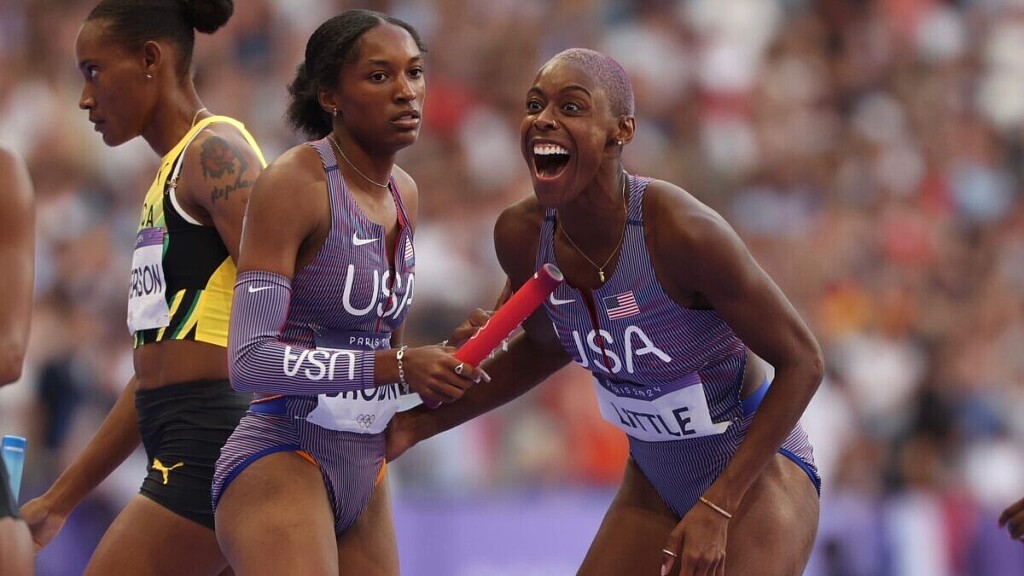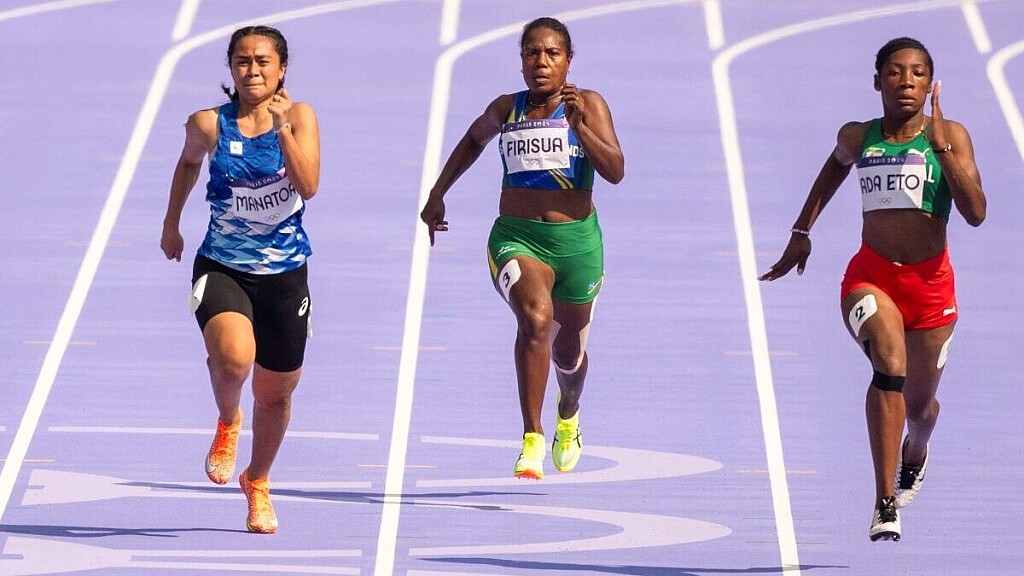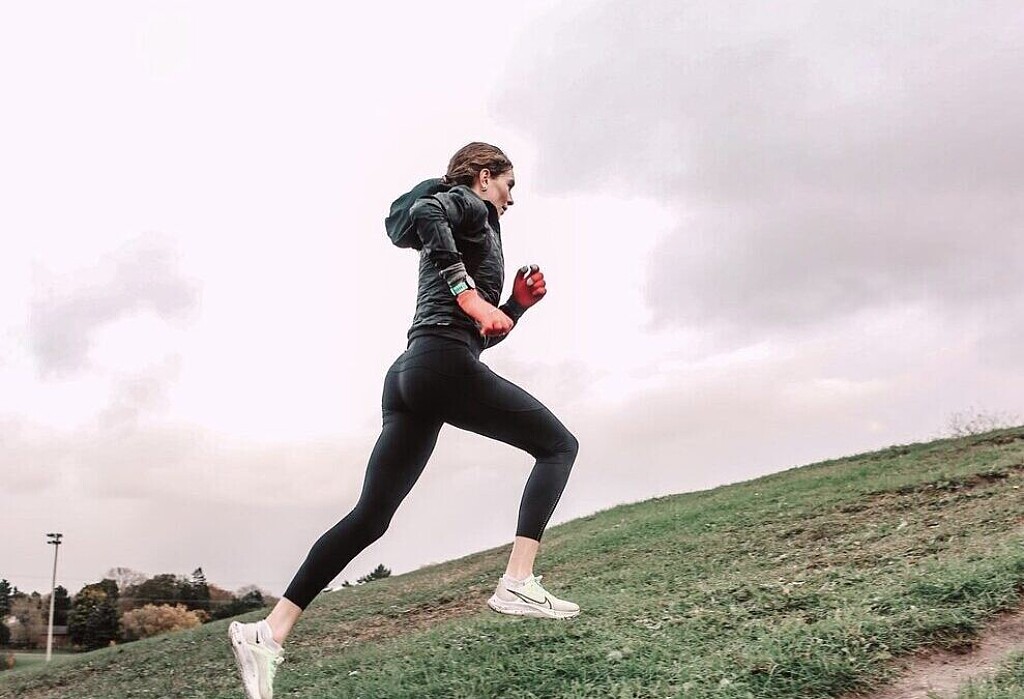Running News Daily
Top Ten Stories of the Week
8/10/2024
These are the top ten stories based on views over the last week.
Olympic Track and Field Stars Are Wearing Luxury Watches. Why?
IN TRACK AND FIELD, tenths (and even hundredths) of a second can make or break a race. Performance depends on extremely precise measurements and time rules all. So it makes sense that luxury watch brands would look to those athletes as natural billboards, placing their timepieces on the wrists of some of the sport's top performers.
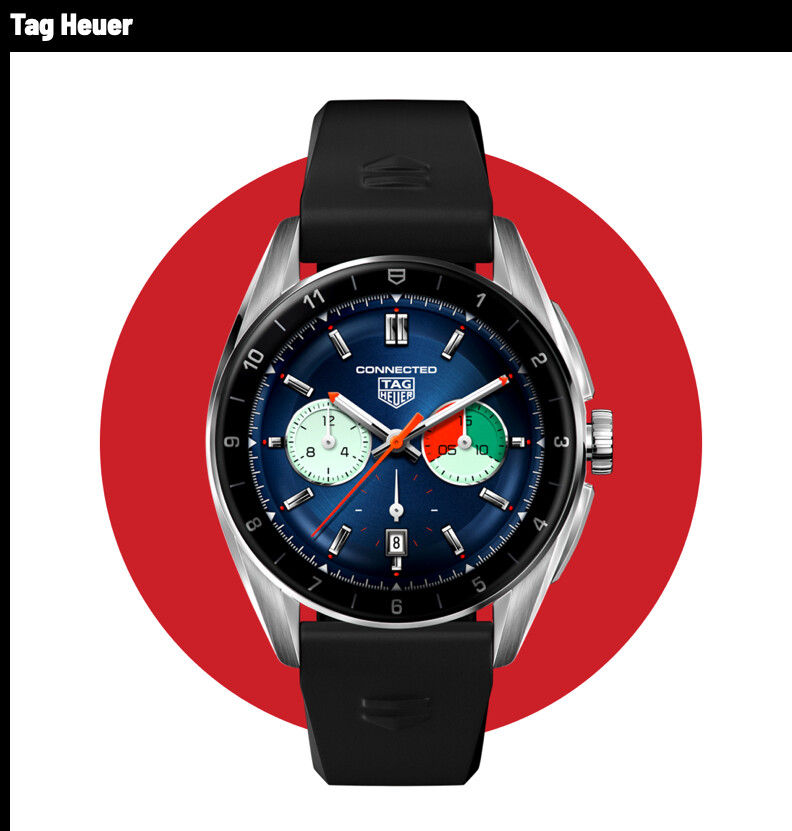
When Noah Lyles, the fastest man in the world, settled into the blocks for the 200-meter finals at the U.S. Olympic Trials in June, 4.5 million viewers tuning in via NBC and Peacock could see the glint of the sun off what appeared to be a $50,000 Omega watch.
Wearing this type of timepiece during a 19.53-second sprint is clearly a flex, since “there’s no performance reason for [these athletes] to wear luxury watches,” explains Aaron Rapf, the founder and CEO of Advantage Sports Marketing Group, a sports agency that connects brands with athletes.
Runners are no stranger to pricy performance watches (a high-end Garmin can cost upwards of $900), and luxury watch companies are increasingly aligned with elite runners to “connect their company values to the sports landscape—which is one of the last bastions of true culture,” he adds. “If you want to be in a moment where you attract millions of people’s eyeballs at one time, it’s sports.”
These race day cameos are part of a more subtle approach to marketing, says Pierre-Loïc Assayag, CEO and co-founder of Traackr, an influencer marketing software company. “In the past, luxury brands were more focused on the product and the luxury associated with that product,” he says. “Now, these companies are taking the top athletes and putting them in front of their target audience, or one close to it, to demonstrate by proximity that ‘we are the precision brand’ or ‘we are the endurance brand.”
The kind of maneuvering uses a third party—one that’s fast, flashy, and accomplishing amazing feats—to craft an image the brand wants audiences to respond to. And by choosing athletes as brand champions, companies deftly align themselves with the hallmarks of high performance: precision, prestige, innovation, exclusivity, heritage, and craftsmanship.
In the past, those buzzwords were more likely to call to mind country club-esque activities (think: tennis or horseback riding) or auto racing, where the traditional consumer has been very upper class, living a high-cost lifestyle. But as culture skews more towards sport, health, and wellness, leaning into the popularity of running opens companies up to a new class of consumers, says Jessica Quillan, a luxury fashion brand and content strategist. “Track and field seems more accessible, because even though these athletes are performing at a super elevated level, anyone can go out and run,” she explains.
By association, watches become a more accessible form of wearable luxury. You may not wear one to train or on race day like the elite, sponsored atheltes, but a sporty aesthetic can translate into your everyday life; post-run, you can still swap your COROS smartwatch for a sleek, sporty timepiece from a brand like Omega (which happens to sponsor the Diamond League, an annual series of pro track and field competitions). And though you may not be ready to buy a five-figure watch now, these companies are playing the long game; by connecting themselves with major players in sport, they’re hoping to build brand recognition and loyalty among potential future customers.
The Watch Brands Olympic Runners Are Wearing
For those looking to upgrade their Garmin—now or as a future reward for finally achieving that personal best—these are a few of the luxury watches your favorite track and field stars have been sporting.
Two-time Olympic gold medalist Sydney McLaughlin-Levrone, who will represent Team USA in Paris again after breaking her own World Record in the 400-meter hurdles in June, has been sponsored by Tag Heuer since 2021.
Tag Heuer is often considered the Cadillac of luxury watches, and McLaughlin-Levrone’s preferred watch, the Connected Calibre E4, is closest to the average runner’s GPS smartwatch: It operates on Wear OS by Google; has a 1.28-inch AMOLED display with crisp resolution; houses a heart rate sensor, barometer, and compass; and holds a 24-hour charge, including a one-hour sports session. The basic model, which includes a rubber strap, starts at $1,250.
Olympic bronze medalist Josh Kerr is a double World Champion—in the 1,500-meter and 3,000-meter—which made him a natural representative for Swiss watch brand Longines, the official partner and timekeeper of the 2022 Commonwealth Games in Birmingham. Kerr, who is not currently working with Longines, recently ran a 3:45.34 in the Bowerman Mile, a historic and prestigious race held annually at the Prefontaine Classic in Eugene, OR, to set a new world-leading time in the event and a new British record. Back in 2022, Kerr wore the-limited edition HydroConquest XXII Commonwealth Games, a sporty steel dive watch with an automatic caliber, or engine, one-directional ceramic bezel, luminescent indices and hands, and an anti-reflective coating for crystal clear readability in any situation.
In addition to their Paris 2024 partnership, Omega is the official sponsor of the Diamond League (an annual series of elite track and field competitions) and counts Noah Lyles—one of the biggest personalities in track and field—as an ambassador. Lyles, who earned a bronze medal in the 200-meter race at the 2020 Tokyo Games and has his sights on breaking Usain Bolt’s records in the 100- and 200-meter races, wears Omega’s iconic Speedmaster Moonphase.
This style was introduced in the 1980s, but the latest model—an oversized, steel-on-steel timepiece—was the first to earn a Master Chronometer certification thanks to a self-winding engine designed to withstand temperature fluctuations, water immersion, and electromagnetic frequencies. The timepiece can also hold up to the shock that comes with covering 100 meters in less than 10 seconds (when it's on Lyles's wrist, at least).
Sprinter Dina Asher-Smith is the fastest British woman on record, with two Olympic bronze medals from the 4 x 100-meter relay to her name. She’s also no stranger to luxury partnerships, having previously modeled for Louis Vuitton, Valentino, and Off-White, and has been working with Hublot since 2018. Asher-Smith has promoted a variation on Hublot’s flagship model, the Big Bang One Click, which starts at $14,200.
Its smaller face was designed for slimmer wrists, and uses the brand’s patented “One Click” fastening system so wearers can swap out the straps for other colors or materials. The sporty, semi-skeletonized hands balance out flashiness of the diamonds on the bezel, and a self-winding caliber packs plenty of power into the compact timepiece.
Ahead of what she says will be her final Olympic Games, Jamaican sprinter Shelly-Ann Fraser-Pryce—the most decorated athlete in 100-meter history—announced a partnership with Richard Mille. Fraser-Pryce wears the RM 07-04 Automatic Sport, the first women’s sports watch from the McLaren of watch brands, which retails at $185,000 (it’s the same watch Nafi Thiam, a double Olympic champion from Belgium, wore while setting a new pentathlon world record in 2023). The skeletonized aesthetic is housed in a compact case with rigid finishings for shock-resistance, and the button on the side allows the wearer to switch between winding, neutral, and time setting modes for the crown. While it would be nearly impossible to read during a race, at 36 grams it’s lighter than most standard running watches.
(08/03/24) Views: 154Men’s Health
There Are Going to Be People Walking:’ A Look at the Grueling Olympic Marathon Course
Getting to run by all those historic spots requires some epic climbs and descents.The final weekend of the 2024 Paris Olympics will host back-to-back days of thrilling marathons. These prestigious races, set against the backdrop of two of France’s most iconic landscapes—Paris and Versailles—will weave through a tapestry of history, culture, and breathtaking scenery. They begin on August 10 with the men’s race, and then, in a nod to the 40th anniversary of the first women’s Olympic Marathon in Los Angeles, the Paris Olympics will conclude on August 11 with the women’s race for the first time in history.
Here are some of the key details you’ll want to know:
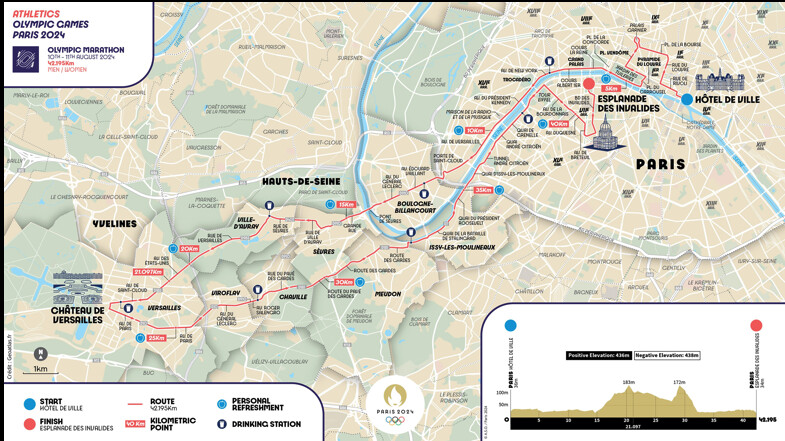
What sites will the runners pass?
It’s not a bad way to tour the area, and it’s quite different than the Paris Marathon that is held each April. Athletes will find themselves tracing a route that dances through nine arrondissements (neighborhoods) of Paris along the banks of the Seine. The runners will begin at the Hôtel de Ville, or city hall, and then pass landmarks such as the Palais Garnier opera house, Place Vendôme, the Louvre museum, and past the Trocadéro.
Next, they will leave the city to run through historic French towns, including Sevres, on their way to Versailles. The return to the city is a different route and will take them through the Forêt Domaniale de Meudon, a forest. When back in the city, they will be on the Left Bank and run past the Eiffel Tower as well as Parisian neighborhoods. The race ends at the Esplanade des Invalides, in which Napoleon is buried.
This route is based on significant French history. In October 1789, between 6,000 and 7,000 Parisian women, joined by men, marched from the Hôtel de Ville through the city to Versailles. It was because of that march that Louis XVI agreed to ratify the Universal Declaration of the Rights of Man and Citizens. The marathoners are symbolically running in their footsteps.
How tough is the course?
Unlike some more recent Olympics and U.S. Marathon Trials races, this course isn’t a circuit of repeated loops. Instead, it’s a full loop starting in Paris and loops down to Versailles outside of the city.
While the elevation profile for the first nine miles looks fairly tame, once the runners are past the halfway mark the landscape changes. The most notable course feature is the three uphill stretches—they’re incredibly steep and very long.
The first big hill comes just before the 10-mile mark, and it climbs at a 4 percent grade, which is roughly the same as Boston’s famed Newton hills. The difference with the Paris version is that it ascends for about 1.25 miles before it levels off for a bit. (Boston’s longest hill is less than half a mile, according to Sean Hartnett, emeritus professor of geography at the University of Wisconsin-Eau Claire, who specializes in marathon routes and other running competitions.)
The next hill at the 12-mile mark is at 5 percent, steeper than anything on the Boston course and 900 meters long. But those two are just appetizers for the real challenge. That hits just after the 18-mile mark.
Runners will have to climb for 600 meters, at an average grade of 10.5 percent. Yes, picture putting your treadmill at 10 percent and trying to run up it at marathon pace. Hartnett calls it a “doozy” and struggles to find courses to compare it to. The Bix 7 in Davenport, Iowa, perhaps? Then he gives up. “It’s unlike anything in any competitive road marathon,” he said. (You can view a detailed description of the 15K-33K section as mapped by Hartnett here.)
In total, the route will include 1,430 feet of elevation gain. Possibly more challenging is the 1,437 feet of descent. The make-or-break point for the route might be just after that final brutal uphill, when they are bombing downhill—at some points at a gradient of 13.5 percent. Runners will have to be efficient going down, without pounding so much they trash their quads before the final flat stretch before the finish. To put the course into some more perspective, the World Marathon Majors that are considered the hilliest—Boston and New York City—each have an elevation gain of a little over 800 total feet. And for one final nugget, the average grade of the Mount Washington Auto Road Race is 12 percent. The course record for that 7.4-miler is at around 8:00 pace.
This course will make the fastest marathoners in the world look almost human at times.
How do the marathoners feel about the course?
Pat Tiernan, an Olympian for Australia who is running the marathon, made two trips to Paris from his training base with Puma in North Carolina to examine the course. His first trip, in early April, was just to get a feel for the course. The second, in late May, was to train on it.
“The first thing you notice,” Tiernan said in a phone call with Runner’s World, “is that it’s going to be a brutal course. There are going to be people walking.”
If you look closely at the official Strava route, you can spot some U.S. Olympic marathoners on the leaderboards of the course’s toughest segments.
On April 10, U.S. team member Clayton Young did a 12.80-mile run on the hilliest section of the course, where he “pushed the uphills, chilled the downhills.” During the steepest climb—right before the mile 18 split—Young tackled a .44-mile segment in 3:09, giving him a modest average pace (for a world-class marathoner) of 7:01 per mile. But if you look at Strava’s “grade adjusted pace,” which factors in elevation, that 7:01 converts to 5:03 mile pace. His average heart rate was 179 beats per minute.
Dakotah Lindwurm, a U.S. team member for the women, also previewed the course in April in a run she called, “Tour de La Olympic hills ?].” She racked up an impressive 16 “course records” during her 10.87-mile workout, and on the same steep segment that Young ran, she averaged 7:43 pace with a grade-adjusted pace of 5:21 per mile.
Emily Sisson, the U.S. record holder in the marathon, has been training for both the hills and the flats. “We’ve been doing a lot of stuff on hills, because [we] want to come out of the hills into the last 10K feeling good,” she says. “That’s also why you don’t want to slack on 10K work, because it could be quite fast at the end. So kind of trying to do it all.”
Tiernan agreed with Sisson on the unique challenge. If marathoners go too hard through the hills, they could struggle at the end, he said. If they go too easy through the hills and subsequent descents, they might be out of touch by the final 10K. He said the Paris course is as “if you were to do a 10K road race, then go and run a hard 10K hill cross country course, then a 10K road race.”
If nothing else, it could make for some surprises on the podium.
When exactly are the races?
The men’s event happens on Saturday, August 10. If you want to watch live, get your favorite espresso ready. The event begins at 2 a.m. ET/11 p.m. PT in the U.S. The following day for the women’s race, the 2024 Paris Olympics fully conclude in honor of the 40th anniversary of the first women’s Olympic marathon event, won by Joan Benoit-Samuelson. The start time is also at 2 a.m. ET/11 p.m. PT.
Who are the major names in each race?
Both races are packed with star power in the form of returning Olympic champions, world record holders, and World Marathon Majors winners. The biggest storyline in the men’s race is whether Eliud Kipchoge, the two-time Olympic marathon gold medalist who many consider to be the greatest of all time, will be able to retain his crown in what may be his final Olympics at age 39.
The women’s event is even more stacked and should make for quite the event to cap off the 2024 Olympics. Newly ratified world record holder Tigist Assefa of Ethiopia will have to match speed and strategy against the likes of Hellen Obiri and Peres Jepchirchir of Kenya and the Netherlands’s Sifan Hassan, who is running the marathon after racing in the 5,000 and 10,000 meters on the track.
Men’s Marathon Contenders
Eliud Kipchoge, Kenya (2:01:09)
Kenenisa Bekele, Ethiopia (2:01:41)
Benson Kipruto, Kenya (2:02:16)
Tamirat Tola, Ethiopia (2:03:39)
Conner Mantz, USA (2:07:47)
Clayton Young, USA (2:08:00)
Women’s Marathon Contenders
Tigist Assefa, Ethiopia (2:11:53)
Sifan Hassan, Netherlands (2:13:44)
Peres Jepchirchir, Kenya (2:16:16)
Emily Sisson, USA (2:18:29)
Hellen Obiri, Kenya (2:21:38)
Rose Chelimo, Bahrain (2:22:51)
Fiona O’Keeffe, USA (2:22:10)
Sharon Lokedi, Kenya (2:22:45)
Did you know there is a mass participation race?
If not, now you do. It’s called the Marathon Pour Tous, and we’re pretty jealous we can’t run this one. There will be a full marathon and a 10K on the same route as the Olympic marathon on the evening of August 10. Yes, a night race in the City of Lights. More than 20,000 participants are expected for each event.
(08/04/24) Views: 134Runner’s World
American Cole Hocker grabs gold from Josh Kerr as Jakob Ingebrigsten and Timothy Cheruiyot wilt in epic 1500m final
America's Cole Hocker shocks world with by clinching 1500m Olympic gold as Ingebrigsten, Kerr and Kenya's Timothy Cheruiyot miss out.
In a breathtaking display of speed and strategy, America’s Cole Hocker defied all expectations to win gold in the men’s 1500 meters at the Paris 2024 Olympic Games.
Hocker, who was not widely tipped to be a podium contender in a race stacked with talent, outpaced pre-race favorites Jakub Ingebrigtsen, Josh Kerr, and Kenya’s Timothy Cheruiyot to clinch victory and set a new Olympic record of 3:27.65.
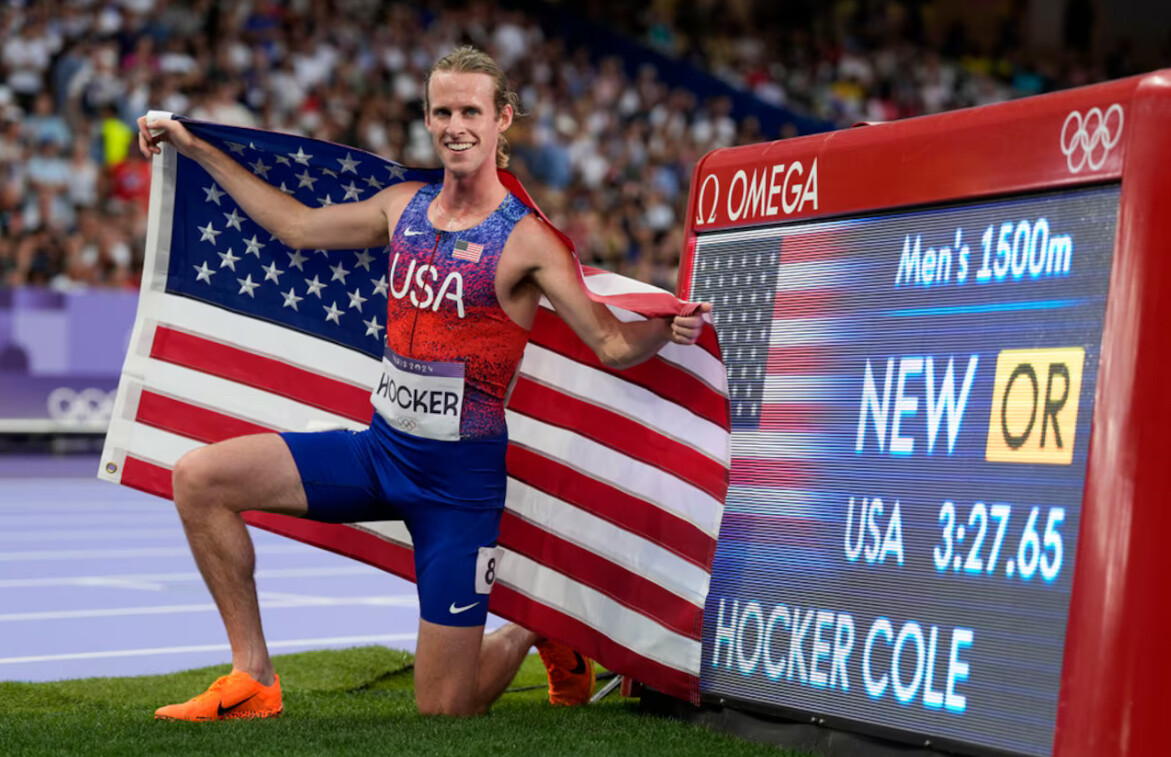
The race, which featured three Americans in the final for the first time in Olympic history, saw Hocker apply relentless pressure on Kerr alongside compatriot Yared Nuguse.
In the final 50 meters, Hocker surged ahead, leaving Kerr and the rest of the field in his wake. Kerr had to settle for silver, finishing in 3:27.79, with Nuguse narrowly taking bronze in 3:27.80.
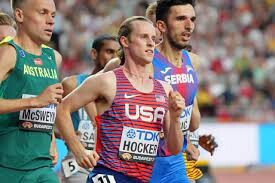
The race was full of surprises, especially with Cheruiyot, the 2019 world champion, fading dramatically in the last 200 meters to finish a disappointing 11th place. His compatriot, Brian Komen, struggled even more, finishing last with a time of 3:35.59.
Jakub Ingebrigtsen, known for his typical backfoot approach where he waits to make his move in the final stages, adopted a different strategy this time.
He led the charge in the first 800 meters, with Kerr and Cheruiyot close behind, setting a blistering world-record pace after the first lap. As the race progressed, it became clear that the final lap would be a dramatic showdown among the front runners.
With 200 meters to go, Cheruiyot and Komen both started to wilt under the intense pace, falling behind as Kerr and Ingebrigtsen battled for the lead. However, Ingebrigtsen, too, began to fade in the closing stretch, allowing Kerr to take control and seemingly secure the gold.
But it was Hocker who had the final say. Taking advantage of Kerr's inability to maintain his pace, Hocker surged past him in the final meters, crossing the finish line first.
The victory was sweetened by the Olympic record he set, a testament to his superb race execution. Hocker celebrated his monumental achievement by thumping his chest and ringing the bell, signaling his arrival on the world stage.
Hocker’s triumph is a significant moment in Olympic history, showcasing the depth of talent in American middle-distance running and marking him as one to watch in future championships.
(08/06/24) Views: 119Mark Kinyangui
New 10,000m Olympic Record in maybe one of the best 10000m ever
In what could be argued as the most gruelling track race of the Olympic Games, the 10,000m, it was an epic battle in the men’s final, as the reigning Olympic champion, reigning world champion and current world record holder were all in the lineup at the Stade de France to battle for the coveted Olympic gold medal.
Taking the fastest 10,000m race in the history of the Olympic Games was Uganda’s world record holder, Joshua Cheptegei, in a time of 26:43.14.
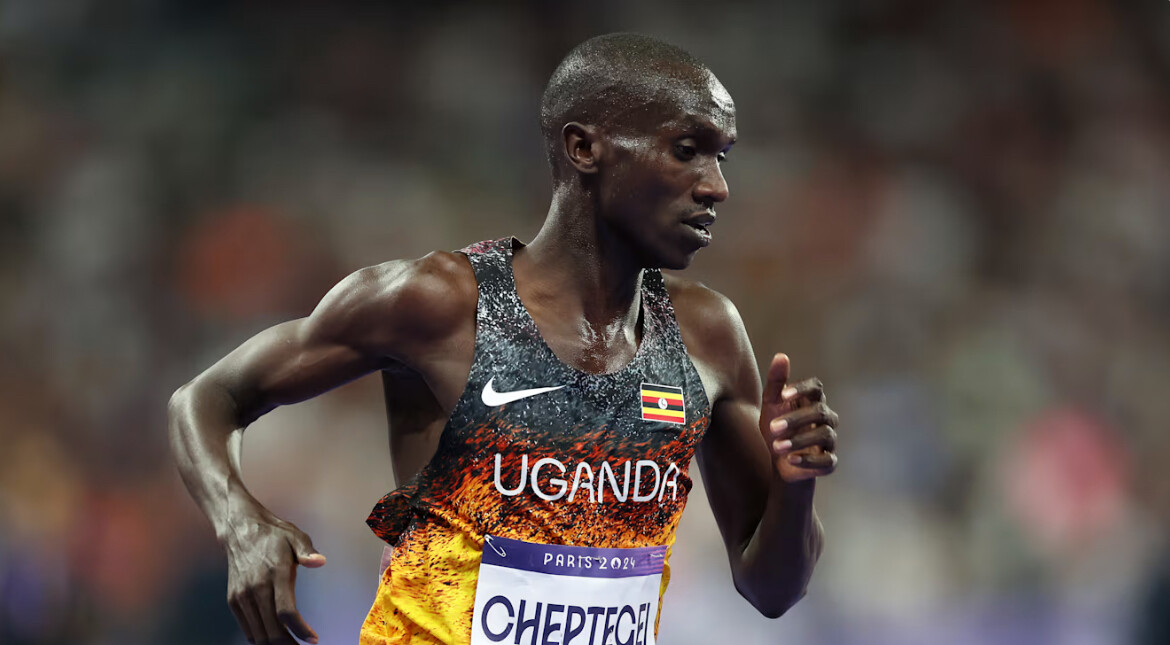
The pool was incredibly fast, with the first 13 finishers all coming in under the previous Olympic record, that before Friday night had held true since 2008.
Ethiopia’s Berihu Aregawi took the silver medal just 0.3 seconds behind Cheptegei, with USA’s Grant Fisher taking the bronze medal, 0.02 behind silver.
Reigning Olympic champion Selemon Baregaof Ethiopia took seventh place in 26:44.48.
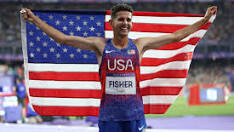
More: Joshua Cheptegei of Uganda took the lead with a little more than a lap left in a masterpiece of a 10,000-meter race to finish in an Olympic-record 26 minutes, 43.14 seconds in front of a roaring crowd on an electric opening night at the track.
The world-record holder raced in the middle of a strung-out pack for most of the 25 laps on the calm, cool evening at the Stade de France.
Then he took off, and held the lead over the final 500 meters against a crowd of Ethiopians who set a blistering pace all night.
Ethiopian Berihu Aregawi beat American Grant Fisher in a sprint to the line for silver.
Fisher’s bronze medal marked the first for the U.S. in the longest race at the Olympic track since Galen Rupp took silver in 2012.
(08/02/24) Views: 110Paris 2024: Sobbing Mozambique sprinter the latest victim of the cruelest rule in sports
PARIS — Hands on his head, tears in his eyes, Mozambique sprinter Steven Sabino walked off Stade de France’s distinctive purple track and disappeared down a tunnel.
The 18-year-old could scarcely believe that he would fly back from the Olympics without even getting to compete.
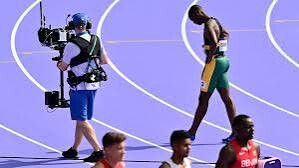
Only moments earlier, Sabino was at the start line for the second heat of the men’s 100 meters prelims, but he sprang out of the blocks before the starting gun sounded. Track officials ruled that he false started and showed him a red card indicating that he had been disqualified.
“We went into a set position and I heard a bang,” Sabino said between sobs 10 minutes later. “I don’t know where it came from. Probably the pole vault. I don’t know. I heard a bang, the kind of bang that you hear when the electronic gun goes off.”
Sabino briefly pleaded his case to track official Vadim Nigmatov, pointing to his ears to indicate what he’d heard. He said that he asked to run the race under protest, but Nigmatov and the other officials refused.
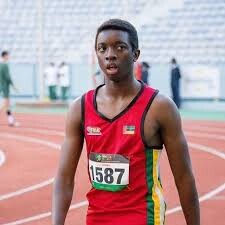
“They didn’t even hear what I had to say,” Sabino said. “I sacrificed everything for this.”
Sabino’s plight is the latest reminder that track and field’s zero-tolerance false start policy might be the cruelest, most unforgiving rule in sports. It’s more sudden than a sixth foul in the NBA Finals, more damaging than a red card at the World Cup and more common than an unsigned scorecard at one of golf's majors. It has induced tantrums from otherwise mature adults and waylaid some of the legends of the sport — even the great Usain Bolt.
Only an hour after Sabino's false start, the rule took out another runner. Great Britain's Jeremiah Azu false-started in his round 1 heat and also was disqualified without getting to run.
Azu, like Sabino, said he "heard something and just reacted." He planned to appeal his disqualification in hopes of being granted a chance to run by himself and try to qualify for the Sunday's semifinal on time.
"Right now, I'm acting as if I'm running again," he said
International track and field’s governing body went to a zero-tolerance false start policy over a decade ago out of a desire to streamline the sport and eliminate gamesmanship.
Under the old rules, sprinters or hurdlers notorious for slow reaction times would attempt to gain an edge by guessing when the starting pistol would fire, knowing the penalty would be charged to the field rather than to themselves. The multiple false starts slowed down meets and made it difficult for TV networks working within a specific time slot.
(08/03/24) Views: 106Jeff Eisenberg
History maker: USA’s Grant Fisher takes bronze in men’s 10,000m at Paris Olympics
Grant Fisher joined Lewis Tewanima (1912), Billy Mills (1964) and Galen Rupp (2012) as the only American men to medal in the 10,000m at the Olympics, winning bronze in a close final on Friday night at the Stade de France.
Fisher was narrowly pipped to the line by Ethiopa’s Berihu Aregawi, who picked up the silver in a photo-finish.
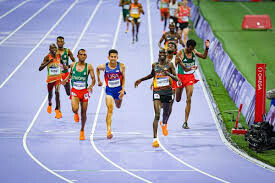
There were also strong efforts from Americans Nico Young (26:58.11) and William Kincaid (27:29.40), who finished 12th and 16th. But it was Fisher who made US history. In a cool night in Paris, he ran his best time of the season, clocking in at 26 minutes, 43.46 seconds. Aregawi ran a 26:43.44.
“I’ve been close to the medals before,” Fisher said. “But I haven’t gotten one until today.”
Fisher’s bronze marked the first US medal in track and field at the Paris Games.
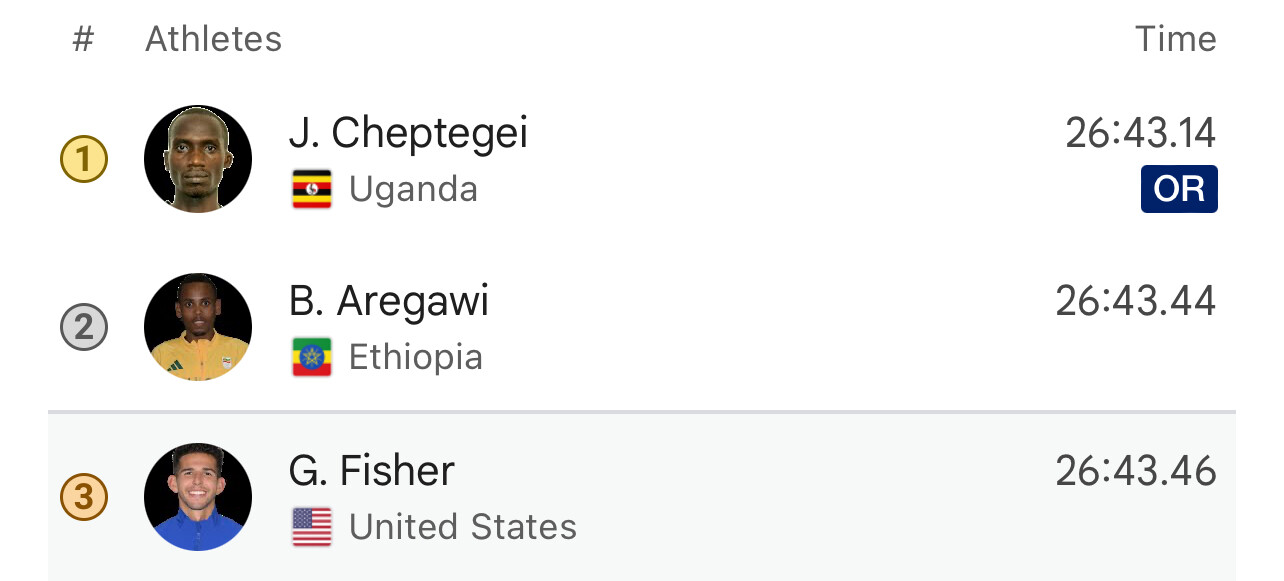
“So many things have to go right to get on the podium,” said Fisher, who finished fifth in the 10,000m in Tokyo. “I’m happy that they did.”
After stumbling with about nine laps to go, Fisher surged back to reach the lead group heading into the final laps. Whether or not the American could hold on for a medal was a question, but who would take home the gold was never in doubt.
Joshua Cheptegei of Uganda took the lead with a little more than a lap left in a masterpiece of a 10,000m final to win in an Olympic-record 26:43.14 seconds in front of a roaring crowd on an electric opening night for track at the Paris Games.The world record-holder raced in the middle of a strung-out pack for most of the 25 laps on the calm. Then he took off around the curve and held the lead over the final 500 meters against a crowd of Ethiopians who set a blistering pace all night.This was Cheptegei’s season opener on the track this season – his only race at this distance was a 26:53 run in a cross-country road race earlier this season.
He looked in peak form, turning a race being controlled by Aregawi and his Ethiopian teammates, who strung out the pack early and took turns in the lead, into a celebration for Uganda, which captured its first gold in the 112-year history of this race at the Olympics.The win earned Cheptegei $50,000 – a new prize for Olympic track this year – and a chance to ring the bell at the end of the stadium that is reserved only for newly crowned Olympic champions.
Cheptegei adds this to the silver medal he won in Tokyo and the world titles he took in 2019, 2022 and 2023.“Now, my collection is complete,” he said. “I was the world champion. Now, I win the Olympic title. I’m so excited.”
(08/03/24) Views: 106Guardian sport
Montenegrin Olympian runs 100m on broken foot to honor late father
Montenegro's Darko Pešić broke his foot two days ago, but he did not let that stop him from competing in the men's 100m.
Two days before his Olympic debut, Montenegrin athlete Darko Pešić broke his foot during a training session. Despite doctors and the Montenegro Olympic Committee advising him not to compete, Pešić decided to honour his late father by lining up in the men’s 100m prelims.
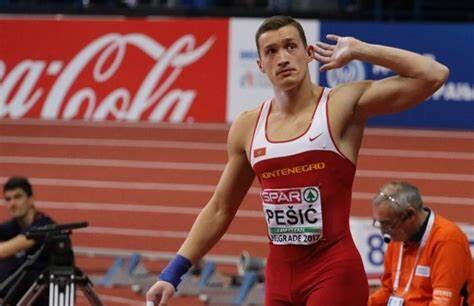
Pešić spent the last two days in a walking boot, removed the cast and took to the blocks in the men’s 100m prelims, running 11.85 seconds on a broken foot.
“The 100m was not for me; it was for my father, who passed away four years ago and paved the way for me in this sport,” Pešić told Canadian Running in a post-race interview. “When I crossed the line, it meant everything to me. Because of him, I am the man I am today.”
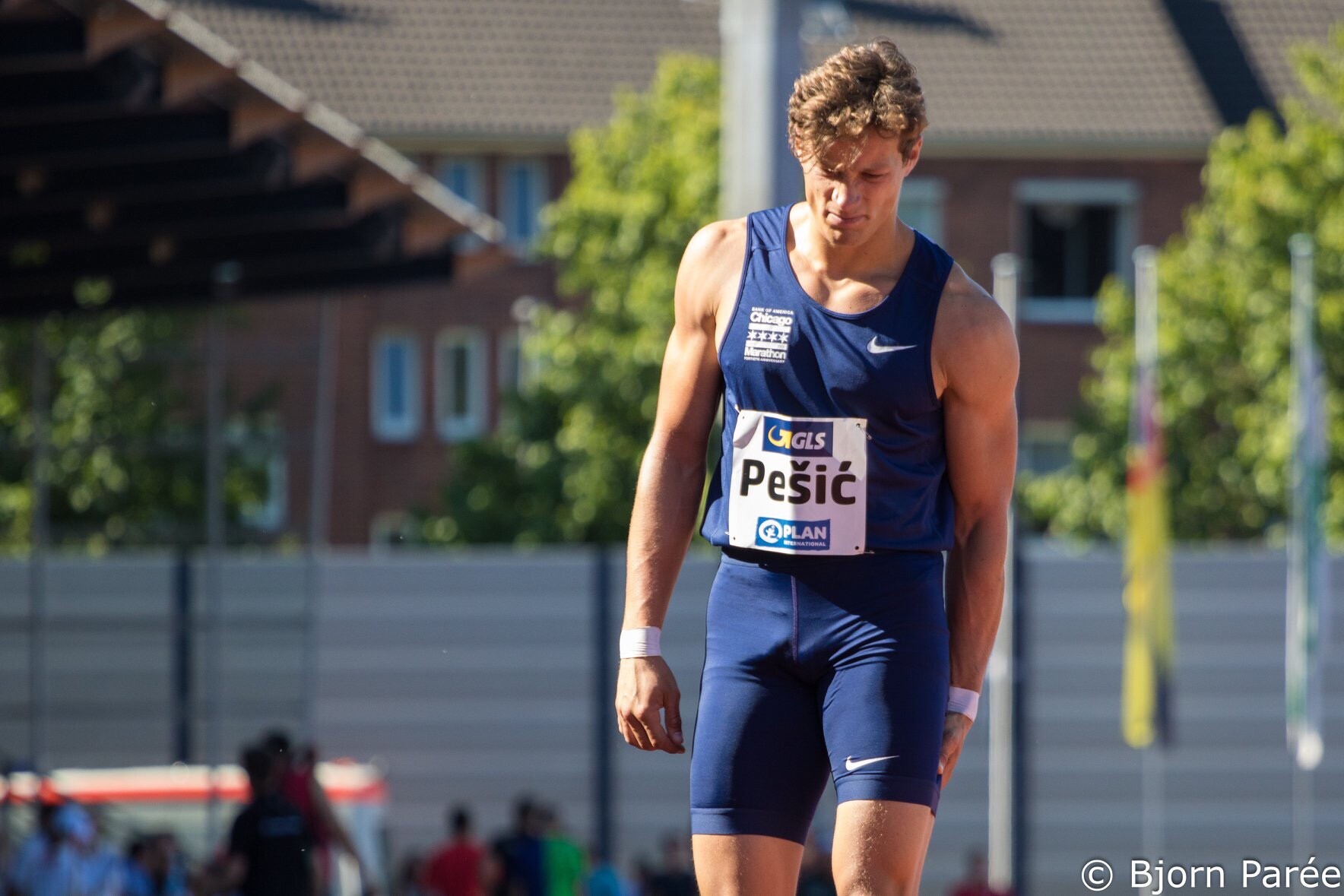
Primarily a decathlete, Pešić does not usually compete in the men’s 100m. He was given a spot via the World Athletics universal spot program, which aims to ensure broader global representation by allowing athletes from countries with less-developed sports programs to participate in the Olympics.
The 31-year-old explained he sustained the injury on Thursday while doing a plyometric workout (jumping exercises). “I went to the medics in the village, and they gave me a walking boot,” Pešić said. “The doctors said I would not be able to run for six weeks.”
His country advised him not to compete and risk the rest of his career due to the seriousness of the injury, but Pešić said he couldn’t give up.
“The time or place did not matter,” Pešić said. “Even if I walked the 100m, I still would’ve enjoyed it. Being an Olympian means more than anything.”
Pešić hopes to return to the decathlon once he recovers, with aspirations to compete next year at the Götzis Hypomeeting in Austria and the 2025 World Championships.
Athletics events at the Paris 2024 Olympic Games are taking place from Aug. 1-11. Today’s coverage is brought to you by Canadian Running and New Balance Canada. Follow us on Twitter on Instagram for all things Team Canada and up-to-date exclusive news and content.
(08/03/24) Views: 106Marley Dickinson
Team USA destroys mixed 4×400 world record in heats
On the opening day of track and field at the Paris Olympics, the U.S. has already set the stage for the incredible performances to be expected over the next week. Team USA’s mixed 4x400m relay knocked down the first world record of the competition on Aug. 2–in heats. The squad demolished their own previous world by more than a second–clocking 3:07.41.
Vernon Norwood, Shamier Little, Bryce Deadmon and Kaylyn Brown were tasked with securing a top three finish in their heat in the relay. They went above and beyond to take down the country’s previous world record in the event, 3:08.80, set at the 2023 World Championships in Budapest.
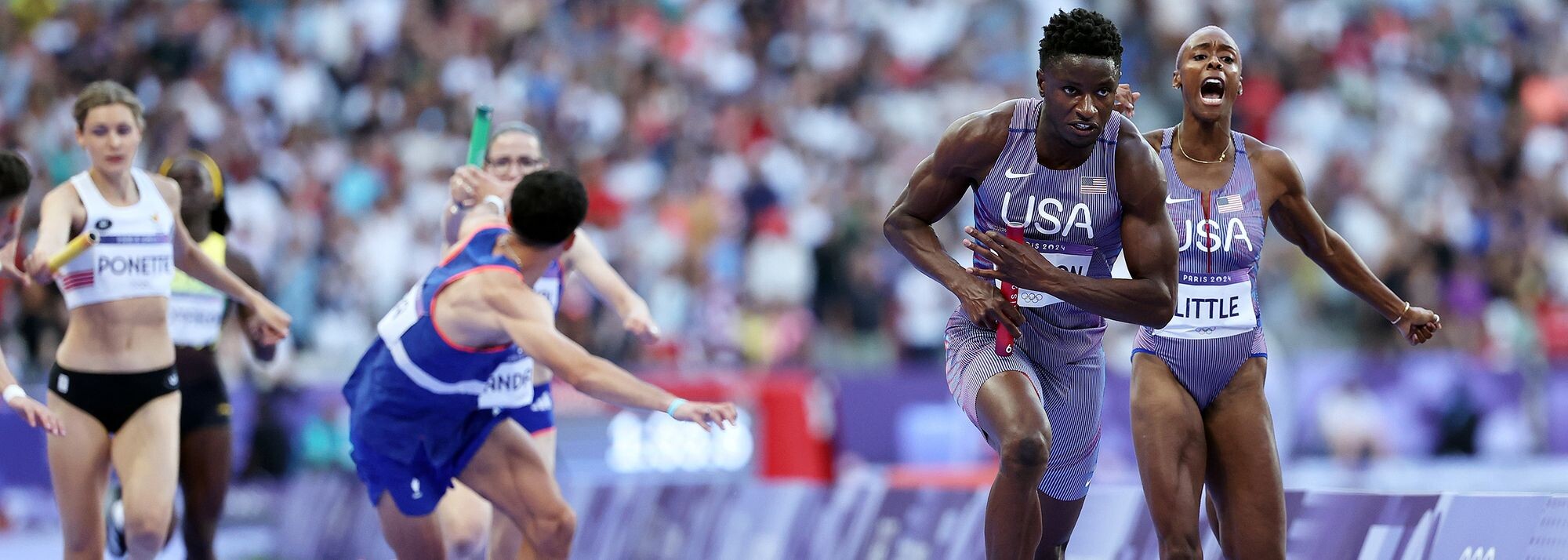
Team USA won the entire round by more than three seconds, with France as the next-fastest team, finishing in 3:10.60 in front of their home crowd. Four other teams in the heat achieved new national records.
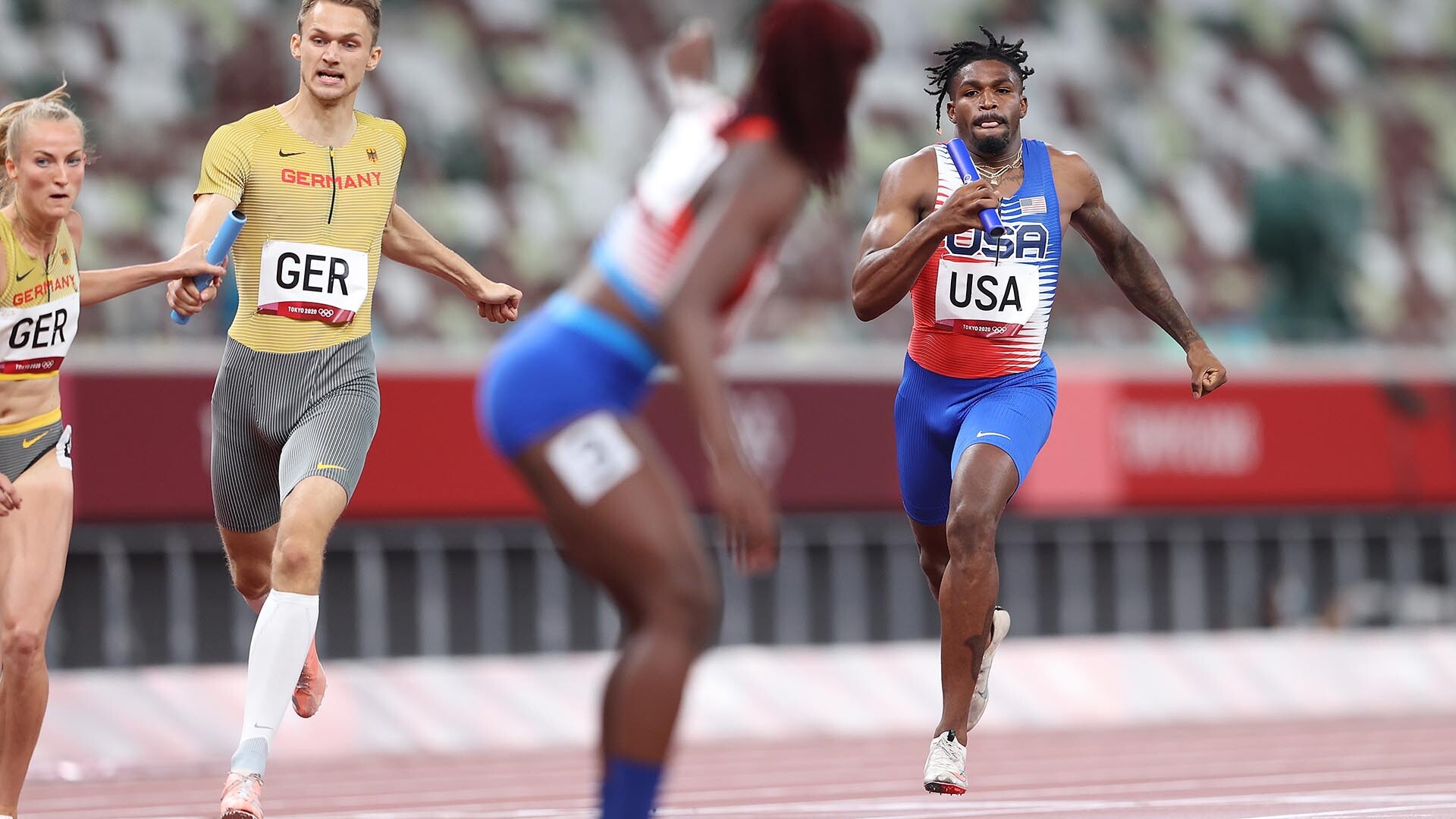
“I’ve gotten quite a few practices in over the last few days and we’ve just gotten better,” Shamier Little told media after running the second leg for the Americans. “We’ve got great chemistry.” Both of the next-fastest qualifying times for the final came from their heat.
The mixed 4x400m relay final will take place on Aug. 3 at 2:55 p.m. ET.
Athletics events at the Paris 2024 Olympic Games are taking place from Aug. 1-11. Today’s coverage is brought to you by Canadian Running and New Balance Canada. Follow us on Twitter on Instagram for all things Team Canada and up-to-date exclusive news and content.
(08/03/24) Views: 105Marathoner runs 100m for the first time at Paris Olympics
Until today in Paris, Sharon Firisua of the Solomon Islands had never run a 100m race.
Of the 87 athletes in the women’s 100m at the Paris 2024 Olympics, Sharon Firisua of the Solomon Islands stood out for one specific reason. She was the only athlete who had never run a 100m race before the 2024 Paris Olympic Games.
On Friday morning in the women’s 100m prelims, Firisua quickly fell behind out of the blocks, finishing last and nearly three seconds behind the first-place finisher, with a time of 14.31 seconds.
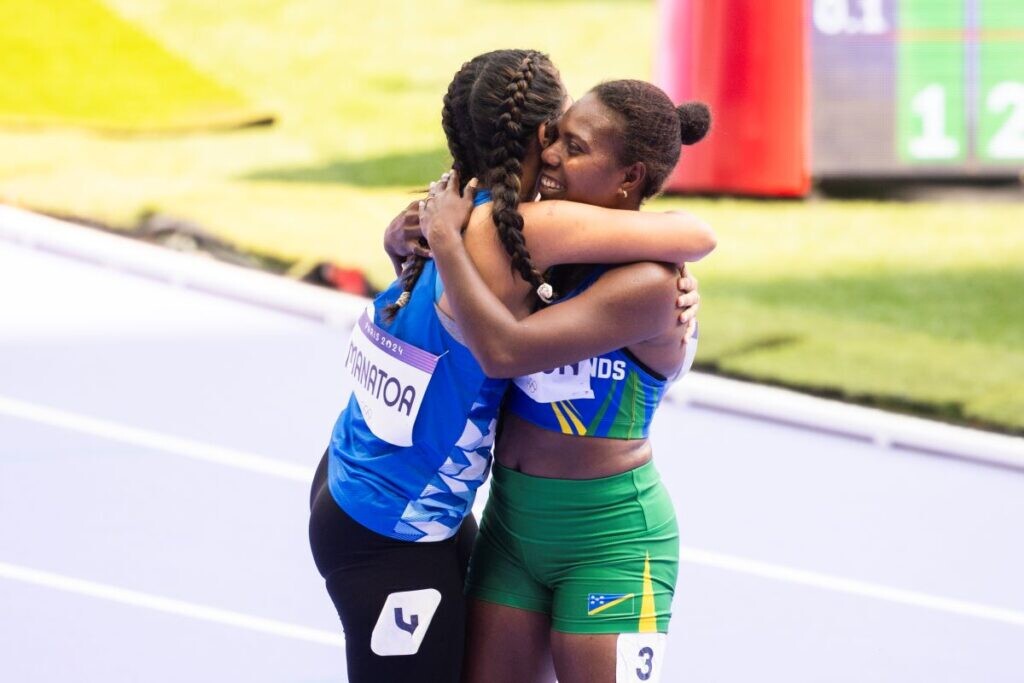
The 30-year-old marathon runner from the small Oceanic nation previously competed at the Tokyo Olympic Games in the women’s marathon, finishing 72nd out of 73 entrants with a time of 3:02:10.
You might be wondering how Firisua qualified for the Games despite never having raced this distance. She was granted a universal spot for the women’s 100m via the Solomon Islands Athletic Federation. Universal spots at the Olympics ensure broader global representation by allowing athletes from countries with less-developed sports programs to participate and become Olympians.
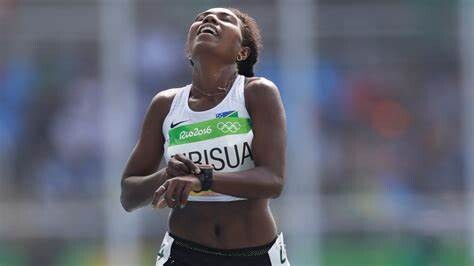
Firisua is one of two athletes from her nation at the Paris Olympics, the other being women’s 50m freestyle swimmer Isabella Millar.
Despite her lack of sprinting experience, Firisua is a celebrated athlete in her homeland. She has won five gold medals at the Pacific Games–in the 5,000m, 10,000m and half-marathon events–and is a six-time medallist at the Oceania Championships, with four golds. In 2013, she was named her country’s sportswoman of the year.
Athletics events at the Paris 2024 Olympic Games are taking place from Aug. 1-11. Today’s coverage is brought to you by Canadian Running and New Balance Canada. Follow us on Twitter on Instagram for all things Team Canada and up-to-date exclusive news and content.
(08/03/24) Views: 105Marley Dickinson
Three hill sprint workouts that beat the heat
These hill sprint sessions pack a powerful punch in a short amount of time.
Hill sprints are a perfect summer workout because they pack a powerful punch in a short amount of time, meaning you don’t have to spend hours in the heat to see significant gains. We have three workouts to get you started.
These high-intensity sessions build both strength and speed, improve running economy and add a refreshing change to your regular routine.

1.-The classic
For this workout, find a hill with a moderate incline—it should be challenging, but one that you can sustain a fast pace on for at least 30 seconds.
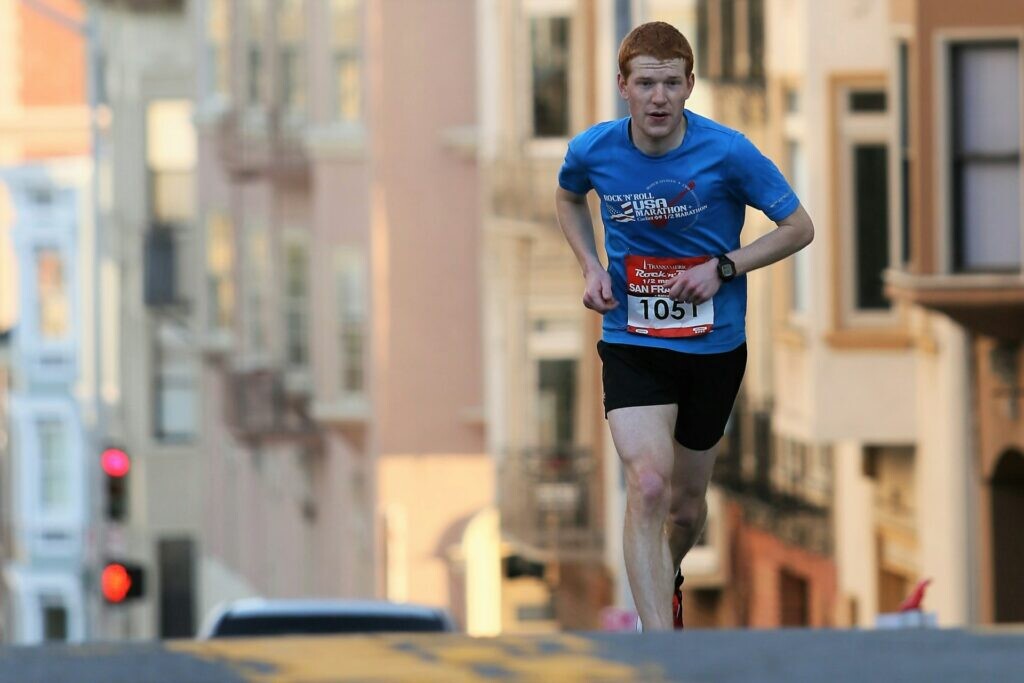
Warm up with 10 minutes of easy running.
Sprint uphill for 20-30 seconds at a medium-high intensity—slightly under your maximum effort.
Walk or jog back down for recovery (1-2 minutes).
Repeat 6-8 times.
Cool down with 10 minutes of easy running.
2.- Perfect pyramid
Warm up with 10 minutes of easy running.
Sprint uphill for 15 seconds, walk or jog down for recovery.
Sprint uphill for 30 seconds, walk or jog down for recovery.
Sprint uphill for 45 seconds, walk or jog down for recovery.
Sprint uphill for 60 seconds, walk or jog down for recovery.
Reverse the order: 60, 45, 30, 15 seconds, walking or running slowly down for recovery in between.
Cool down with 10 minutes of easy running.
3.-Short and steep
Find a hill with a steep incline for this workout—one that you can still run up, but only for a short stretch.
Warm up with 10 minutes of easy running, followed by some dynamic stretches.
Sprint uphill for 10-15 seconds at maximum effort.
Walk or jog back down for recovery (1-2 minutes).
Repeat 8-10 times.
Cool down with 10 minutes of easy running.
Forget about your flat-pace goals when tackling these hill sprints. Running uphill will naturally slow you down, and warm weather adds an extra challenge. But don’t worry—you’re still getting an incredible workout that will lead to better overall performance.
(08/02/24) Views: 102Keeley Milne


